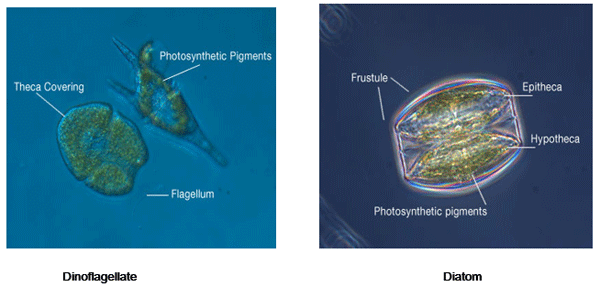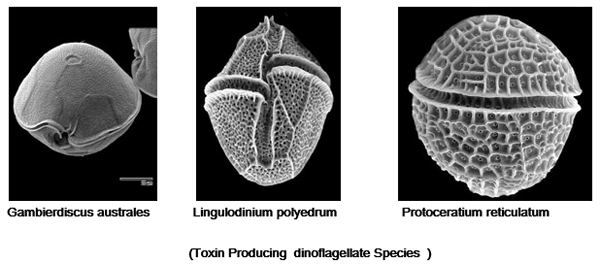Harmful Effects on Toxin Dinoflagellates in Shrimp Culture Ponds
Published: March 20, 2014
By: Mr. Prakash Chandra Behera, Technical Manager (Aquaculture Division) PVS Group , India
Phytoplankton are the key food item in both aquaculture and mariculture. Both systems are utilizing phytoplankton as food for the animals being farmed. In aquaculture, phytoplankton must be obtained and developed artificially through various adapted procedures. The plankton population in form of desirable bloom undertaken throughout the culture period as part of best pond management practice. Phytoplankton is used as a food stock for the production of zooplankton which are in turn used to feed cultured organisms.
Living dinoflagellates are one of the most important components in phytoplankton. Many dinoflagellates are primary producers of food in the aquatic food webs. Dinoflagellates are an integral part of the first link in the aquatic food chain: the initial transfer of light energy to chemical energy (photosynthesis).

The dinoflagellates along with other phytoplankton enter in to the aquaculture pond through water intake from adjacent tide water. Due to applied nutrients and water conditions, immediately the dinoflagellates proliferate its bloom in desire level or sometimes in heavy blooms which is harmful to pond condition. These blooms appear in red-brown or red -green water coloration.


Dinoflagellates
- Eukaryotic single-celled algae
- Many have two flagella, which allow the cells to have limited mobility
- Cells are covered by a theca (sheath) that can be smooth or ornamented
- Some species are able to migrate vertically through the water column, seeking nutrients, prey, or protection from harmful UV rays.
- Nearly half of known species are capable of photosynthesis and contain light-harvesting pigments (autotrophs)
- Some species survive by other nutritional modes, and may absorb organic matter or engulf prey (heterotrophs)
- Many species employ a combination of autotrophic and heterotrophic behaviors
Of the 2000 known species, about 60 are able to produce complex toxins .Dinoflagellates are a very successful group, at times to the detriment of the ecosystem. When conditions are favorable, a population explosion or bloom may occur, sometimes resulting in contamination of fish and shellfish and posing a threat to human and animal health.
The growth of dinoflagellates are regulated by several factors including water, temperature, solar irradiation, turbidity, and nutrient concentrations. Acidic pond water is typically treated with calcium-based compounds aiming to raise the pH and promotes the growth of phytoplankton. Nutrients are supplied by the use of fertilizers and artificial feeds in which aquaculture ponds usually meet the ideal conditions for phytoplankton growth.
LUMINISCENCE EFFECT OF DINOFLAGELLATE:
These are tiny plants in plank tonic form live in sea water and obtain source of energy from sunlight during day. In darkness the dinoflagagellates emit bright blue light( luminescence) in response to movement within water. This mechanism is regulated by activity of enzymes (luciferases) upon luminescent (luciferins) and requires oxygen. The dinoflagellates are making flash light during dark time and light became brightest after several hours of darkness. The glowing activities is reduced in early morning and there is no longer to luminescence upon shaking.
HARMFUL TOXIN EFFECTS OF DINOFLAGELLATE
Dinoflagellate 'blooms' (cell population explosions) can cause discoloration of the water (known as red tides) which can have harmful effects on the surrounding sea life and aquaculture. When toxic species are in bloom conditions ,the toxins can be quickly carried up the food chain and indirectly passed into other consumers via fish and shellfish consumption, sometimes resulting in gastrointestinal disorders, permanent neurological damage, or even death. Some dinoflagellates species produce toxins that can kill both finfish and shrimp and indirectly to other consumers.
There are different types of harmful dinoflagellate blooms.
- Gonyaulax polygramma - Cause oxygen depletion
- Dinophysis acuta sps - Diarrhetic Shellfish Poisoning (DSP)
- Gambierdiscus toxicus, Ostreopsis mascarenensis - Ciguatera Fish Poisoning
- Alexandrium acatenella sps - Paralytic Shellfish Poisoning (PSP)
- Karenina breve sps - Neurotoxin Shellfish Poisoning (NSP);
- Gymnodinium mikimotoi.- Harmful to fish ,shrimp and marine invertebrates .The cells may cause damage or clog the gills of these animals.
HARMFUL EFFECTS OF DINOFLAGELLATE TO SHRIMP HEALTH
- Dinoflagellate 'blooms' can cause critically damages to cultured shrimps by toxin effects and sudden fluctuation of water parameters of culture pond.
- shrimps deaths occur because of large numbers algal cells become trapped in the creatures' gills, causing respiratory failure, hemorrhaging, or bacterial infection . Species of the diatom genus Chaetoceros, for example, become lodged in the gills, where their spiny filaments destroy the hosts' tissue.
- Depletion of dissolved oxygen level increases of ammonia content and toxic gasses in pond water.
- Instability of pH and promote to inhabitant of pathogenic organisms in pond.
- Increase the chance of diseases and microbial load in pond.
- Appearance of gill diseases, annetena rot etc, less appetite, poor growth, bad molt, soft shell, low survival rate and chance of mass mortality of shrimps.
CONTROL MEASURES
- Avoid the water intake to shrimp farms during red bloom phase (red tide) from near water sources.
- Follow the best management practice to prevent the entry of bloom water in shrimp pond.
- Do not exchange pond water if blooming phase occur near water sources.
- If no bloom observed in adjacent intake water , exchange maximum water in possible period.
- In severity condition, operate aerators for more period and stop the periodical nutrients to pond water.
- Strictly follow the feed management practice.
TREATMENTS
- Treat the pond water with required doses of chlorine etc to during the pond preparation.
- For best result use quality algaecide or de- dinoflgellate product to pond water during culture period.
- In critical conditions, use oxygen developer and ammonia adsorbent products immediately followed by application of zeolite product.
- Apply best soil & water probiotics products to pond for better results in 2-3 weeks intervals.
- Also, application of soluble aluminum iron compound have greater effectiveness for removing phosphorus from pond nutrition concentration and controlling dinoflagellate growth.
- Use of required doses of Ferric chloride or ferrous sulfate has the potential to reduce phosphorus concentration for lowering bloom density.
Proper pond and water quality management is essential to successful and quality shrimp production. Maintaining a good culture environment through use of proper management practices will reduce the risk of disease and increase production, shrimp quality, and marketability.
Related topics
Authors:
Join to be able to comment.
Once you join Engormix, you will be able to participate in all content and forums.
* Required information
Would you like to discuss another topic? Create a new post to engage with experts in the community.
Create a post2 de marzo de 2015
02.03.2015
Dear Mr. Prakash Chandra Behera
Kindly throw some more light on the followings;
What are the most commonest toxin producing dinoflagellates found in shrimp ponds (Peneus monodon & P.vennamei) in India? Do you often experience toxin producing dinoflagellate blooms? What are the luminescence dinoflagellates in shrimp ponds? We here in Sri Lanka, some times experience luminescence dinoflagellates with dips in production performances but not toxin producing dianoflagellatrtes.
More than the mechanical injuries by the the cell wall processes of the diatom Chaetocerus which are brown algae, usually bloom in shrimp ponds at higher salinities, it is the organic matter that begins to decay after an algal crash that causes problems.
8 de abril de 2017
Is there any possibility of frequent dinoflagellate blooms causing low survival rates and retarded growth in the shrimp ponds?. Can the toxic effect the of dinoflagellates can cause disproper functioning of hepatpancreas in shrimp juveniles or adults. Do diniflagettates have any role in the slow growth syndrome nowadays commonly seen during the culture of P. Monodon .
1 de marzo de 2017
Sir, in one of my pond water colour is back brown. How to prepare for catching blooms?
27 de diciembre de 2016
In one of my pond water color is full of blackish brown ? Even pH fluctuation in a day in almost 0.8-1.
I had applied zeolite products,liming but too it's not changing .
And weekly 40cm water exchange is going on and with that within week 10-15hours flow through .
Daily around 12hrs sludge removing .
But too water color is not changing . Why? What can I do for this ? Any solutions ?
2 de diciembre de 2016
In my pond prawns are converted colour to red and 2 or 3 days after they becomes dead what can i do water depth is 3½ feet and mud is ½ feet pond is 5 acrs and prawns are max 3 to 4 lks i experts
1 de julio de 2016
How to control plankton in shrimp pond without changing water in semi intensive culture
11 de octubre de 2015
Dear prakash Chandra behera,
Can you give detail explain about how ferrous sulfate and ferric chloride work on dinoflagellate blooms
11 de octubre de 2015
Sir,
What is the best method to control dark green colour water during culture period. About 80-90doc










.jpg&w=3840&q=75)